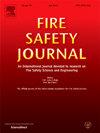A numerically accurate mathematical framework for simulations of firebrand transport in landscape-scale fire spread models
IF 3.4
3区 工程技术
Q2 ENGINEERING, CIVIL
引用次数: 0
Abstract
We consider in the present study an evaluation of the numerical accuracy of the dominant approach used to model the transport of firebrands in landscape-scale fire spread simulators. The approach is based on a prescribed statistical distribution for downwind ember flight distance combined with a model for flight time. The present study assumes instantaneous ignition of spot fires following landing of firebrands on the ground, a simplification that is not realistic but one that allows performing simple verification tests for which an exact solution is available. The present study considers both a Eulerian version and a discrete particle (called Lagrangian) version of the firebrand transport model. The results of the verification tests show that the firebrand models are “numerically accurate” or “converged”, i.e., are insensitive to changes in numerical parameters provided that a set of conditions are satisfied. It is found that in the Eulerian firebrand model, numerical accuracy is controlled by the wind-based Courant-Friedrichs-Lewy (CFL) number, whereas in the Lagrangian firebrand model, numerical accuracy is controlled by both the CFL number and the generation rate of computational particles. These results provide a solid mathematical foundation for simulations of firebrand transport in landscape-scale fire spread simulators.
在景观尺度火灾蔓延模型中模拟火种移动的数值精确数学框架
在本研究中,我们考虑对景观尺度火灾蔓延模拟器中用于模拟火焰传播的主要方法的数值精度进行评估。该方法基于规定的顺风余烬飞行距离统计分布,并结合飞行时间模型。本研究假设在火把落在地面后,现场火灾会瞬间点燃,这种简化并不现实,但可以进行简单的核查试验,并可得到确切的解决办法。本研究同时考虑了火牌输运模型的欧拉版本和离散粒子(称为拉格朗日)版本。验证试验结果表明,只要满足一组条件,firebrand模型在数值上是“精确的”或“收敛的”,即对数值参数的变化不敏感。研究发现,在欧拉模型中,数值精度由基于风的Courant-Friedrichs-Lewy (CFL)数控制,而在拉格朗日模型中,数值精度由CFL数和计算粒子的生成速率共同控制。这些结果为在景观尺度火灾蔓延模拟器中模拟火种运移提供了坚实的数学基础。
本文章由计算机程序翻译,如有差异,请以英文原文为准。
求助全文
约1分钟内获得全文
求助全文
来源期刊

Fire Safety Journal
工程技术-材料科学:综合
CiteScore
5.70
自引率
9.70%
发文量
153
审稿时长
60 days
期刊介绍:
Fire Safety Journal is the leading publication dealing with all aspects of fire safety engineering. Its scope is purposefully wide, as it is deemed important to encourage papers from all sources within this multidisciplinary subject, thus providing a forum for its further development as a distinct engineering discipline. This is an essential step towards gaining a status equal to that enjoyed by the other engineering disciplines.
 求助内容:
求助内容: 应助结果提醒方式:
应助结果提醒方式:


